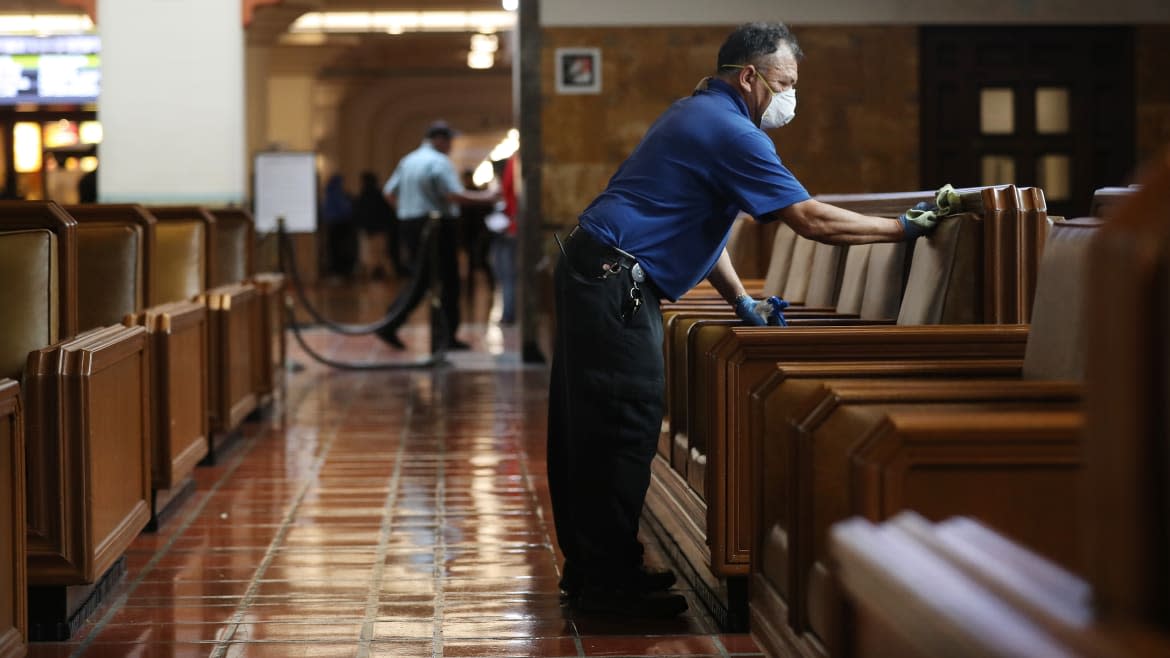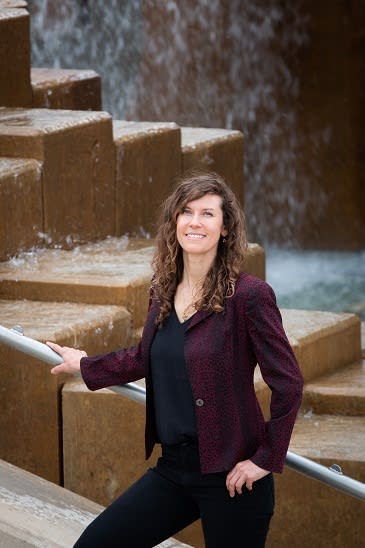Deep Cleaning Won’t Save Us From COVID, and Now We Know Why

- Oops!Something went wrong.Please try again later.
Remember the COVID deep-cleanse? Two years ago, in the early days of the coronavirus pandemic in the United States, many businesses and even homeowners obsessively sprayed disinfectant on open surfaces, aggressively wiping down and scrubbing every countertop and desk and table.
The fear back then was that the SARS-CoV-2 pathogen might survive on and spread via surfaces. People were afraid that simply sitting at a table after an infected person would expose them to COVID-19.
That fear was bunk.
It was soon apparent from contact-tracing and other epidemiological analyses that COVID spread pretty much exclusively via aerosols, those fine mists we all exhale as we breathe, talk, laugh, cough, and sneeze. There are few, if any, documented cases of the novel coronavirus spreading by way of “fomites,” the scientific term for virus-covered surfaces.
What Fighting Airborne COVID-19 Could Actually Look Like
Now we’re finally beginning to understand why this is the case. A new study led by Jessica Kramer, a biomedical engineer at the University of Utah, found that the same spittle that helps spread the virus in the air actually blocks it from later infecting someone via surfaces as the liquid dries.
“Our data indicate that the mucin molecular structure plays a complex and important role in host defense,” Kramer and her teammates wrote in their peer-reviewed study, published on Feb. 14 in ACS Central Science.
The safe, highly effective vaccines (available for free in the U.S.!) are still the best way to protect yourself from COVID, of course. But no vaccine is perfect. As a backup to vaccine-induced immunity, we could make our homes and businesses safer. But as Kramer’s study indicates, a deep clean isn’t the way. “The risk of contracting coronavirus from touching a surface is quite low,” she told The Daily Beast.
That’s not what researchers claimed early in the pandemic. One study, published in The New England Journal of Medicine in April 2020, found that the SARS-CoV-2 pathogen remained “viable” on surfaces for up to three days. Other studies claimed the virus remained viable for up to several weeks.
But there was a problem with those early experiments: prior studies on surface transmission looked at the virus’s survival in water. “But, of course, people don’t sneeze out water,” said Kramer. “They sneeze out mucus.”
Viruses interact differently with water than they do with mucus, Herek Clack, a University of Michigan engineer who specializes in protection from viruses, told The Daily Beast. For one, mucus evaporates slower than water does, Clack said.
More importantly, our snot and saliva contain proteins as well as sugars called “glycans.” Water doesn’t. And those proteins and sugars make a huge difference when it comes to spreading, or not spreading, the coronavirus via surfaces.

Jessica Kramer
“When we add mucus [or] saliva proteins, the virus could no longer infect live cells,” Kramer explained. “Our data explain why epidemiologists have found surface transmission is low-risk in the real world, despite early lab studies that found infectious virus on surfaces for weeks.”
Kramer and her team didn’t actually conduct tests with the SARS-CoV-2 virus, given how dangerous that would be. Instead, they used a different coronavirus called OC43, which causes less severe respiratory infections in people than SARS-COV-2. “The two viruses are structurally very similar so it’s a good surrogate,” Kramer said.
The scientists added samples of OC43 to droplets of cow saliva, which is similar to human saliva, and placed them on a variety of surfaces. They waited varying spans of time (ranging from five minutes to an entire day) for the droplets to evaporate, then exposed the dried-out virus to a “cellular growth medium”—i.e., simulated human tissue.
Then they waited another five days for the virus to infect the samples, something virologists term the “cytopathic effect,” or CPE.
Incredibly, that never really happened. “For the simulated sneeze droplets with mucin, we observed very little CPE from the five-minute dry sample,” Kramer said. After five minutes, virus that splattered onto a surface inside protein-rich mucus was 96 percent less likely to cause infection than virus that landed on a surface inside a protein-free water droplet. After a day, the mucin-soaked virus was 99 percent less likely to cause an infection.
The surface the droplets landed on made no difference. “We tested glass, plastic, metal, and surgical masks and mucus works on all of them,” Kramer said.
So why would mucus cripple the coronavirus? The answer, Kramer and her teammates concluded, lies in the distinctive spike protein that helps coronaviruses grab onto and infect our cells. In a droplet of snot or spit, there are plenty of proteins for the virus’s spikes to grab. The glycans seem to encourage the process. After a few minutes, the spikes are all “full,” so to speak.
It’s a process scientists call “binding.” “We think that the virus and mucus proteins concentrate together when they dry and that improves binding,” Kramer said.
In a sense, the same mechanism that allows SARS-CoV-2 to spread via airborne droplets also greatly limits its spread on surfaces. The difference is wetness. Airborne coronaviruses, when we inhale them, are still wet, so they still have spike proteins that are free to bind to other things, including our healthy cells.
But a virus that’s evaporating on a tabletop somewhere grabs all the proteins it can as the surrounding fluid disappears. By the time the virus is dry, its spikes are full. In Kramer’s experiment, even rehydrating a desiccated virus with a drop of water didn’t restore its infectivity.
“This is an important study as it highlights that mucins and their glycans may play a central role in preventing our bodies from coronavirus infection,” Katharina Ribbeck, a biochemist at the Massachusetts Institute of Technology who was not involved with Kramer’s study, told The Daily Beast.
Obviously, the biggest implication of the new findings is that we can stop stressing about sterilizing surfaces. Sure, a good scrubbing might help keep your kitchen clean and prevent bacterial contamination of food (and clean smell is a nice bonus). But it’s not going to do much to prevent COVID.
Instead, once you’ve gotten vaccinated and boosted, try increasing ventilation of indoor spaces. Fast turnover of indoor air can dissipate the aerosols that are responsible for most COVID transmission. “A greater focus on addressing airborne spread would be good,” Douglas Reed, an expert in respiratory viruses at the University of Pittsburgh, told The Daily Beast.
CDC Warns of Aerosolized COVID-19 Transmission for First Time
But better ventilation is no panacea, of course. “Vaccination, masks and avoiding crowded areas with poor ventilation continue to be our best defenses,” Kramer said.
Kramer said she hopes she and her team, as well as other scientists, will build on this initial study. One goal is to test a wider variety of coronaviruses, ultimately exposing samples of SARS-CoV-2 to a whole lot of actual human mucus.
“We hypothesize that people's mucus will be more or less protective based on their genetics, diet, environment, et cetera, but we have yet to prove that,” Kramer said. “We need to collect, purify and analyze many human mucus samples, which does present challenges—people don't usually like their lungs [and] eyes scraped!”
Kramer’s research could eventually lead to new non-vaccine drugs for preventing COVID. The idea would be to “mimic” the proteins in mucus and somehow incorporate them in a pill that could “block the virus from infecting our cells,” she said.
A hypothetical mucus-based medicine would be a welcome addition to the growing number of prescription pills for treating COVID infections. Unlike anti-COVID drugs such as Pfizer’s paxlovid, you might take the mucus-derived pill before infection sets in. Say, right before or right after exposure to people with COVID.
A mucus-based med is still just an idea, albeit a promising one. For now, it might be reassuring to have hard science to back up what many of us realized a couple years ago. Deep-cleaning your home or business is nice. But it won’t stop COVID.
Correction 2/22/22: The original version of this story misstated the name of the journal ACS Central Science. We regret the error.
Got a tip? Send it to The Daily Beast here
Get the Daily Beast's biggest scoops and scandals delivered right to your inbox. Sign up now.
Stay informed and gain unlimited access to the Daily Beast's unmatched reporting. Subscribe now.

